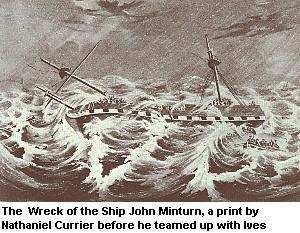| An eyewitness account The Wreck of the John Minturn The disastrous shipwreck off Mantoloking helped lead to the founding of the United States Lifesaving Service. Timelines | Pt. Pleasant Historical Society | Pt. Pleasant History | Images | Sites | Books | Tidbits | End | Send Mail  The wreck of the John Minturn off Mantoloking over a century and one
half ago is among the most significant events in local history. The
shipwreck and several others that year so shocked the nation that the
United States Life Saving Service was created.
The wreck of the John Minturn off Mantoloking over a century and one
half ago is among the most significant events in local history. The
shipwreck and several others that year so shocked the nation that the
United States Life Saving Service was created.
On a February day in 1846 a violent northeast storm accompanied by snow and freezing weather hit the coast. Nine ships were wrecked on New Jersey beaches. The ship Alabama was beached near Manasquan Inlet and rescue efforts failed to save the crew. Just hours later many of the same men involved in that rescue attempt had to turn their attentions to the disabled Minturn off Mantoloking. With the Minturn's sails ripped and the ship in danger of sinking, the captain attempted to beach it, but struck a sand bar 300 yards off shore. Despite 18 hours of rescue efforts and several successful rescues, over 30 lives were lost, including those of the captain, his wife and their two children. Charges that local life savers had looted bodies and the $80,000 cargo were found to be untrue by a special commission created by the Governor of New Jersey. In fact, the commission praised the courage of the locals. Uncle Tommy Cook, 54-years-old at the time of the disaster, was one of the rescuers. Cook came from one of the oldest families in Point Pleasant and was the owner of the Cook Farm at the site of the current Antrim School. His family homestead was one of the first tourist homes in town, perhaps the first place to which tourists came. Twenty-three years after the wreck, in 1869, Cook talked about the it to a visitor from Trenton staying at his home. The visitor made a record of the reminiscences as follows. These are excerpts from that account: "The most fearful storm I ever witnessed was that February 14, 1846. I was awakened at four o'clock in the morning, by the shaking of my bed, as the wind threatened to blow the house from its foundations. While the storm was at its height, about nine o'clock in the morning, we saw just off the shore, through the spray and sleet, The John Minturn, an American barque, with all her sails swept away, drifting to the southward, and approaching shore. She struck to the south of us, about an hour later, where hundreds had gathered, knowing that nothing could save the vessel. "Those on board were not idle. After several attempts and failures, two sailors entered a boat with a rope, and put off for shore. The current carried them so swiftly to the southward, that they were compelled to cut the rope, to save themselves from capsizing. They came safely ashore with the last boat, and found it impossible to return. "At eleven o'clock at night with the storm still raging the Minturn went to pieces. We could hear the wailing shrieks that went up from the despairing ones, as the sea at last caught them in its merciless embrace. The cold was intense, and when the bodies came to in the shore, many were found frozen as rigidly as statues. Quite a number, I recollect, stuck the beach in a sitting position, and thus we saw dead men sitting as upright as in life, as we drew them out of the way of the waves. When day broke again, we saw the bow of the boat still remained intact and a group still huddled together upon it. One mother could be seen, with her babe clasped to her breast, her hair streaming in the wind, and her white face turned upward in prayer, appealing to Him who ruled and ruled above the war of the elements. When this section broke up, it was found that every one of the group had been dead for many hours. There were less than fifty upon the barque of whom thirty-six perished. The body of one man washed ashore fifteen miles down the coast, and was brought to Point Pleasant by a fisherman in his wagon. In a belt around his waist was found $1,500 in gold, which was given to his brother in Philadelphia, who came after the body. "In our little church, I saw at one time forty-two bodies, that with their pale faces and staring eyes looked so life-like that it was hard to believe them dead. The inquest was held, and it being in the dead of winter, we were able to keep the bodies until most of them were claimed; others were buried in our own churchyard."
— Compiled by Carolyn Martin and Victoria Hasset
Timelines | Pt. Pleasant Historical Society | Pt. Pleasant History | Images | Sites | Books | Tidbits | Top | Send Mail
|